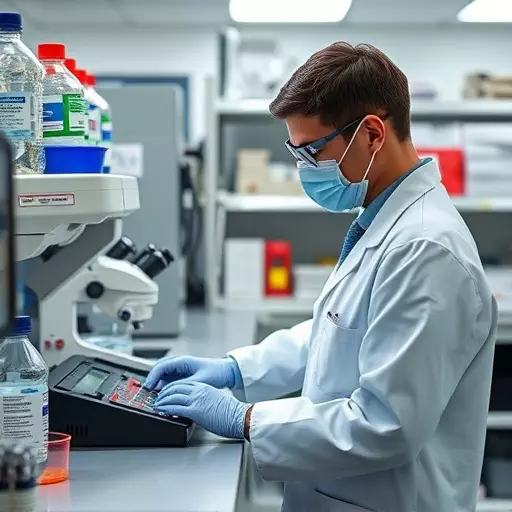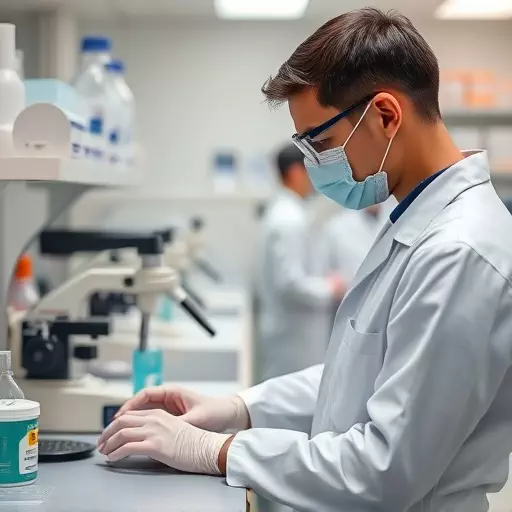The integration of artificial intelligence (AI) into pathology labs in Ann Arbor and globally is revolutionizing healthcare by enhancing accuracy, efficiency, and accessibility of diagnostic services. While AI automates routine tasks, it redefines roles for pathologists, allowing them to focus on complex analyses. The growth of subscription-based diagnostic lab services further accelerates this trend, addressing concerns about automation-related job displacement in Ann Arbor's labs. Key aspects include upskilling personnel, introducing new roles focused on data interpretation and quality control, and managing ethical considerations during this transition.
The growth of AI-powered pathology labs is revolutionizing healthcare globally. From lab work in Ann Arbor to international practices, artificial intelligence is transforming diagnostic accuracy and efficiency. This article explores the current state and future prospects of AI integration in pathology, focusing on its impact on the laboratory workforce, emerging business models like subscription-based services, and cutting-edge technologies driving innovation. Additionally, we address critical automation-related job displacement concerns, reskilling strategies, and ethical considerations as AI shapes global healthcare accessibility.
- The Rise of AI in Pathology: Transforming Lab Work in Ann Arbor and Beyond
- – Exploring the current state of AI integration in pathology labs
- – Case studies: Successful implementation of AI technology
- Addressing Automation's Impact on Laboratory Workforce
- – Examining job displacement concerns due to automation
The Rise of AI in Pathology: Transforming Lab Work in Ann Arbor and Beyond

The integration of artificial intelligence (AI) into pathology labs is revolutionizing lab work in Ann Arbor and globally, marking a significant shift in healthcare diagnostics. This cutting-edge technology promises to streamline processes, enhance accuracy, and efficiency, addressing automation-related job displacement concerns by redefining roles for pathologists. AI algorithms can handle repetitive tasks, allowing human experts to focus on complex analyses and decision-making.
The growth of subscription-based diagnostic lab services further fuels this trend, making advanced pathological assessments more accessible and affordable. In Ann Arbor and beyond, the rise of AI in pathology is fostering a transformative environment where technology complements rather than replaces human labor, ultimately improving patient outcomes and shaping the future of healthcare delivery.
– Exploring the current state of AI integration in pathology labs

The current state of AI integration in pathology labs is marked by a promising yet nuanced landscape. In recent years, the field has witnessed a surge in the adoption of artificial intelligence for various tasks within lab work in Ann Arbor and beyond. This shift is particularly evident in subscription-based diagnostic lab services, where AI algorithms are being leveraged to enhance efficiency and accuracy. From automated sample processing to intelligent image analysis, these innovations are transforming traditional lab workflows.
However, as the growth of AI-powered pathology labs accelerates, addressing automation-related job displacement becomes a critical consideration. While AI promises to streamline many aspects of lab work, it’s essential to ensure that these changes are managed in a way that supports and upskills existing lab personnel rather than displacing them. Balancing technological advancement with workforce continuity will be key as the industry navigates this exciting yet challenging phase of integration.
– Case studies: Successful implementation of AI technology

The successful integration of AI technology in pathology labs across the globe is evident through numerous case studies. In Ann Arbor, Michigan, for instance, a leading research institution has implemented an AI-driven system to streamline lab work, enhancing efficiency and accuracy in diagnostic procedures. This model not only addresses automation-related job displacement but also positions the lab as a pioneer in precision medicine. The system leverages advanced machine learning algorithms to analyze vast amounts of medical data, enabling pathologists to make more informed decisions and improve patient outcomes.
Moreover, the growth of subscription-based diagnostic lab services is another notable trend, reflecting a shift towards data-driven healthcare solutions. These services leverage AI to provide personalized and timely diagnoses, catering to the growing demand for accessible and high-quality health care globally. As AI continues to evolve, it promises to transform not only lab work in Ann Arbor but also healthcare practices worldwide, marking a new era of efficiency and precision in disease diagnosis and management.
Addressing Automation's Impact on Laboratory Workforce

The growth of AI-powered pathology labs is transforming global healthcare by enhancing accuracy and efficiency. However, this technological advancement also raises concerns about its impact on the laboratory workforce. Automation is set to change the nature of lab work in Ann Arbor and beyond. As AI systems take on more tasks, from image analysis to diagnostic reporting, there are fears of job displacement among lab technicians. Addressing automation-related job displacement in labs is crucial for ensuring a smooth transition and reskilling opportunities for affected workers.
The rise of subscription-based diagnostic lab services further complicates the situation. These models, which offer convenient and accessible testing options to patients, put pressure on traditional labs to streamline their processes. While automation can help meet this demand, it’s essential to consider the social implications and ensure that workforce changes are managed ethically, providing support for those transitioning into new roles or industries.
– Examining job displacement concerns due to automation

The growth of AI-powered pathology labs is revolutionizing healthcare globally, but it also raises legitimate concerns about job displacement due to automation in Ann Arbor and beyond. As subscription-based diagnostic lab services expand, there’s a fear that routine tasks currently performed by pathologists and technicians may become automated. However, rather than viewing this as a threat, many professionals see it as an opportunity for specialization and enhanced efficiency. With AI handling repetitive tasks, human experts can focus on more complex cases, improving overall diagnostic accuracy and patient care.
Addressing automation-related job displacement requires proactive strategies. Upskilling and reskilling initiatives can equip lab personnel with the knowledge to work alongside AI systems effectively. Additionally, there’s a growing need for pathologists and technicians to adapt to new roles that emphasize data interpretation, quality control, and critical thinking—areas where human judgment remains indispensable. This shift may also create new positions focused on maintaining and optimizing AI algorithms, ensuring their reliability and accuracy in the diagnostic process.
